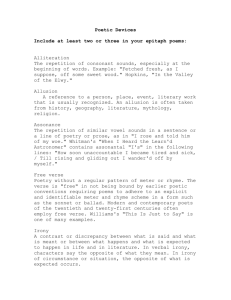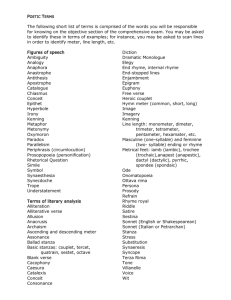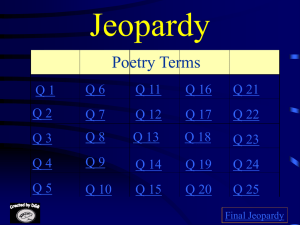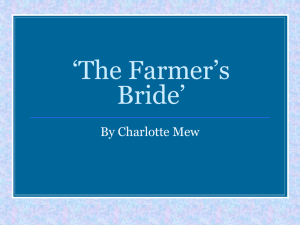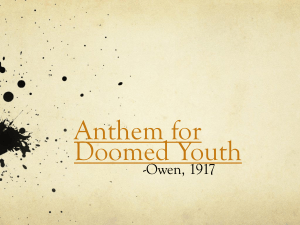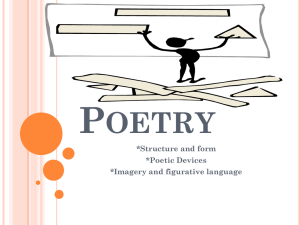Poetic and Dramatic Devices Level 1(choose 3) Level 2 (choose 2
advertisement
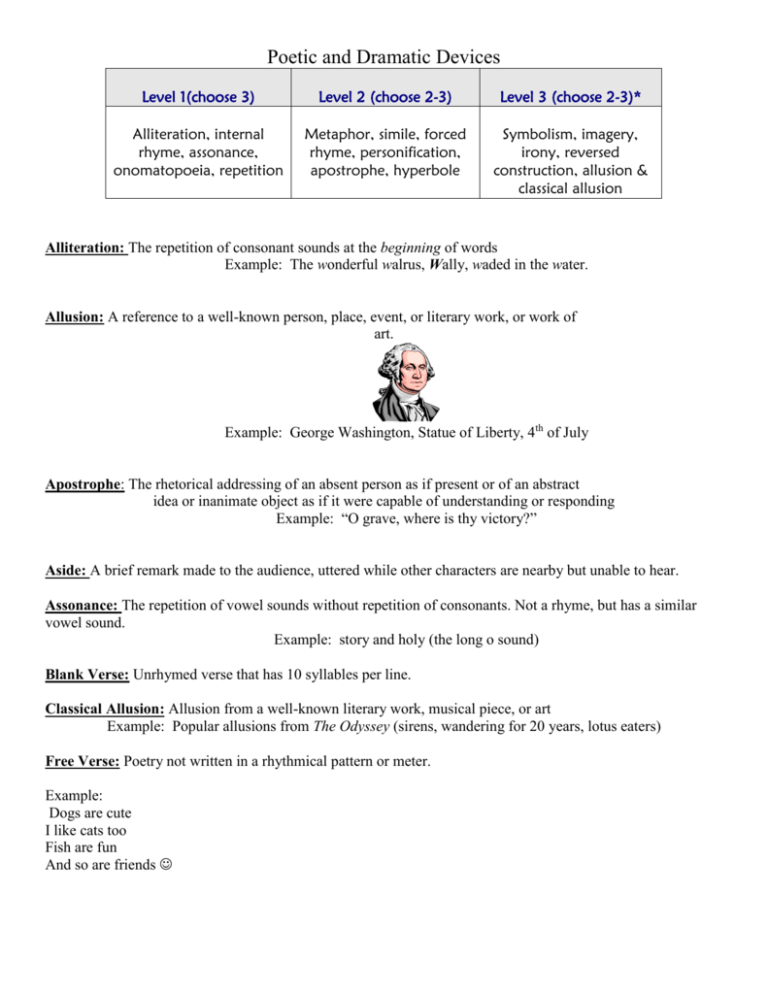
Poetic and Dramatic Devices Level 1(choose 3) Level 2 (choose 2-3) Level 3 (choose 2-3)* Alliteration, internal rhyme, assonance, onomatopoeia, repetition Metaphor, simile, forced rhyme, personification, apostrophe, hyperbole Symbolism, imagery, irony, reversed construction, allusion & classical allusion Alliteration: The repetition of consonant sounds at the beginning of words Example: The wonderful walrus, Wally, waded in the water. Allusion: A reference to a well-known person, place, event, or literary work, or work of art. Example: George Washington, Statue of Liberty, 4th of July Apostrophe: The rhetorical addressing of an absent person as if present or of an abstract idea or inanimate object as if it were capable of understanding or responding Example: “O grave, where is thy victory?” Aside: A brief remark made to the audience, uttered while other characters are nearby but unable to hear. Assonance: The repetition of vowel sounds without repetition of consonants. Not a rhyme, but has a similar vowel sound. Example: story and holy (the long o sound) Blank Verse: Unrhymed verse that has 10 syllables per line. Classical Allusion: Allusion from a well-known literary work, musical piece, or art Example: Popular allusions from The Odyssey (sirens, wandering for 20 years, lotus eaters) Free Verse: Poetry not written in a rhythmical pattern or meter. Example: Dogs are cute I like cats too Fish are fun And so are friends Forced Rhyme: A rhyme that is produced by changing the normal spelling of a word, or by changing the normal structure of a phrase. Example: I hoped that she was heaven-sent, For me I found my heart's cement. Hyperbole: An extravagant exaggeration Example: My house is as tiny as a shoebox; you have to peer at it through a magnifying glass! Iambic Pentameter: A common meter in poetry consisting of an unrhymed line with five feet or accents, each foot containing an unaccented syllable and an accented syllable. Example of pattern: da DUM da DUM da DUM da DUM da DUM Internal Rhyme: Rhyme that occurs within a line of verse. Example: “the grains beyond age, the dark veins of her mother” Imagery: Figurative language that gives a visual explanation of an object or emotion. Through description, one of your senses is appealed to. Example: The cries seemed to come from the watery grave. Irony: A contrast between what is stated and what is really meant Example: Alanis Morrisette’s song, “Isn’t It Ironic” it’s like rain on your wedding day Metaphor: When a word or phrase representing an idea or object is used in place of another to suggest a similarity between them. Example: The girl was a breath of fresh air. Meter: A rhythmical pattern in a line of poetry, which determines its length. Example: (Remember that meter is used in the metric system to determine length!) Monologue: A lengthy speech by one character who addresses other characters – not the audience Onomatopoeia: The formation of words in imitation of natural sounds. Example: buzz Personification: Giving nonhuman objects human-like qualities Repetition: A reoccurring phrase or verse especially at the end of each stanza of a poem or song. Example: Songs have this almost all of the time. Reversed Word or Sentence Construction: A compound word on phrasing place in reversed order. Example: “upfill,” instead of “fill-up” Example: “And from her womb children of divers kind / We sucking on her natural bosom find.” Rhyme Scheme: The arrangement of rhymes in a stanza or a poem Example: ABAB Rhyme: A correspondence in terminal sounds of two or more words or lines of verse. Example: June and Moon Rhythm: A flow of rising and falling sounds in language that is produced in verse by a regular recurrence of stressed and unstressed syllables. Simile: A figure of speech in which things different in kind or quality are compared by the use of the words like or as. Example: The chair was like a pillow. Sonnet: A 14 line poem usually in iambic pentameter rhyming according to a prescribed scheme. Stanza: A division of a poem consisting of a series of lines arranged together in a usually recurring pattern of meter and rhyme. Soliloquy: A speech in which a character, alone on stage…or at least away from the other characters…expresses his or her thoughts to the audience. Symbol: One thing that represents something else. Example: Sunset…representing old age. Theme: The central idea in a poem Example: In Edgar Allen Poe’s “The Raven” Theme: His lost love will be around, “nevermore.” Tone: A feeling the author or speaker is trying to convey to the reader. Example: angry, happy, depressed, comedic.
